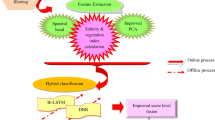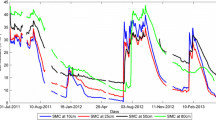Abstract
Soil moisture content (SMC) is a key hydrological parameter in agriculture, meteorology and climate change, and understanding of spatio-temporal distributions of SMC in farmlands is important to address the precise irrigation scheduling. However, the hybrid interaction of static and dynamic environmental parameters makes it particularly difficult to accurately and reliably model the distribution of SMC. At present, deep learning wins numerous contests in machine learning and hence deep belief network (DBN), a breakthrough in deep learning is trained to extract the transition functions for the simulation of the cell state changes. In this study, we used a novel macroscopic cellular automata (MCA) model by combining DBN to predict the SMC over an irrigated corn field (an area of 22 km2) in the Zhangye oasis, Northwest China. Static and dynamic environmental variables were prepared with regard to the complex hydrological processes. The widely used neural network, multi-layer perceptron (MLP), was utilized for comparison to DBN. The hybrid models (MLP-MCA and DBN-MCA) were calibrated and validated on SMC data within four months, i.e. June to September 2012, which were automatically observed by a wireless sensor network (WSN). Compared with MLP-MCA, the DBN-MCA model led to a decrease in root mean squared error (RMSE) by 18%. Thus, the differences of prediction errors increased due to the propagating errors of variables, difficulties of knowing soil properties and recording irrigation amount in practice. The sequential Gaussian simulation (sGs) was performed to assess the uncertainty of soil moisture estimations. Calculated with a threshold of SMC for each grid cell, the local uncertainty of simulated results in the post processing suggested that the probability of SMC less than 25% will be difference in different areas at different time periods. The current results showed that the DBN-MCA model performs better than the MLP-MCA model, and the DBN-MCA model provides a powerful tool for predicting SMC in highly non-linear forms. Moreover, because modeling soil moisture by using environmental variables is gaining increasing popularity, DBN techniques could contribute a lot to enhancing the calibration of MCA-based SMC estimations and hence provide an alternative approach for SMC monitoring in irrigation systems on the basis of canals.
Similar content being viewed by others
References
Akaike H. 1974. A new look at the statistical model identification. IEEE Transactions on Automatic Control, 19(6): 716–723.
Ardekani M R M. 2013. Off- and on-ground GPR techniques for field-scale soil moisture mapping. Geoderma, 200–201: 55–66.
Avolio M V, Di Gregorio S, Lupiano V, et al. 2013. SCIDDICA-SS3: a new version of cellular automata model for simulating fast moving landslides. Journal of Supercomputing, 65(2): 682–696.
Bertoldi G, Della Chiesa S D, Notarnicola C, et al. 2014. Estimation of soil moisture patterns in mountain grasslands by means of SAR RADARSAT2 images and hydrological modeling. Journal of Hydrology, 516: 245–257.
Brocca L, Morbidelli R, Melone F, et al. 2007. Soil moisture spatial variability in experimental areas of central Italy. Journal of Hydrology, 333(2–4): 356–373.
Brocca L, Melone F, Moramarco T, et al. 2010. Spatial-temporal variability of soil moisture and its estimation across scales. Water Resources Research, 46(2): W02516, doi: 10.1029/2009WR008016.
Cervarolo G, Mendicino G, Senatore A. 2010. A coupled ecohydrological-three-dimensional unsaturated flow model describing energy, H2O and CO2 fluxes. Ecohydrology, 3(2): 205–225.
D’Ambrosio D, Iovine G, Spataro W, et al. 2007. A macroscopic collisional model for debris-flows simulation. Environmental Modelling & Software, 22(10): 1417–1436.
Delbari M, Afrasiab P, Loiskandl W. 2009. Using sequential Gaussian simulation to assess the field-scale spatial uncertainty of soil water content. CATENA, 79(2): 163–169.
D’Odorico P, Rodriguez-Iturbe I. 2000. Space-time self-organization of mesoscale rainfall and soil moisture. Advances in Water Resources, 23(4): 349–357.
Famiglietti J S, Wood E F. 1994. Multiscale modeling of spatially variable water and energy balance processes. Water Resources Research, 30(11): 3061–3078.
Famiglietti J S, Rudnicki J W, Rodell M. 1998. Variability in surface soil moisture content along a hillslope transect: Rattlesnake Hill, Texas. Journal of Hydrology, 210(1–4): 259–281.
Furman A. 2008. Modeling coupled surface-subsurface flow processes: A review. Vadose Zone Journal, 7(2): 741–756.
Gao S G, Zhu Z L, Liu S M, et al. 2014. Estimating the spatial distribution of soil moisture based on Bayesian maximum entropy method with auxiliary data from remote sensing. International Journal of Applied Earth Observation and Geoinformation, 32: 54–66.
Goovaerts P. 1997. Geostatistics for Natural Resources Evaluation. New York: Oxford University Press.
Hinton G E, Osindero S, Teh Y W. 2006. A fast learning algorithm for deep belief nets. Neural Computation, 18(7): 1527–1554.
Hinton G E, Salakhutdinov R R. 2006. Reducing the dimensionality of data with neural networks. Science, 313(5786): 504–507.
Hu G C, Jia L. 2015. Monitoring of evapotranspiration in a semi-arid inland river basin by combining microwave and optical remote sensing observations. Remote Sensing, 7(3): 3056–3087.
Ivanov V Y, Bras R L, Vivoni E R. 2008. Vegetation-hydrology dynamics in complex terrain of semiarid areas: 1. A mechanistic approach to modeling dynamic feedbacks. Water Resources Research, 44(3): W03429, doi: 10.1029/2006WR005588.
Ji N N, Zhang J S, Zhang C X. 2014. A sparse-response deep belief network based on rate distortion theory. Pattern Recognition, 47(9): 3179–3191.
Jin R, Li X, Yan B P, et al. 2014. A nested ecohydrological wireless sensor network for capturing the surface heterogeneity in the midstream areas of the Heihe River Basin, China. IEEE Geoscience and Remote Sensing Letters, 11(11): 2015–2019.
Kang J, Li X, Jin R, et al. 2014. Hybrid optimal design of the eco-hydrological wireless sensor network in the middle reach of the Heihe River Basin, China. Sensors, 14(10): 19095–19114.
Kim K J, Cho S B. 2006. Evolved neural networks based on cellular automata for sensory-motor controller. Neurocomputing, 69(16–18): 2193–2207.
Kim Y, Evans R G, Iversen W M. 2008. Remote sensing and control of an irrigation system using a distributed wireless sensor network. IEEE Transactions on Instrumentation and Measurement, 57(7): 1379–1387.
Li H, Li X Y, Ramanathan M, et al. 2014. Identifying informative risk factors and predicting bone disease progression via deep belief networks. Methods, 69(3): 257–265.
Li X, Lao C H, Liu Y L, et al. 2013a. Early warning of illegal development for protected areas by integrating cellular automata with neural networks. Journal of Environmental Management, 130: 106–116.
Li X, Cheng G D, Liu S M, et al. 2013b. Heihe watershed allied telemetry experimental research (HiWATER): Scientific objectives and experimental design. Bulletin of American Meteorological Society, 94(8): 1145–1160.
Liao Y R, Fan W J, Xu X R. 2013. Algorithm of leaf area index product for HJ-CCD over Heihe River Basin. In: Proceedings of 2013 IEEE International Geoscience and Remote Sensing Symposium (IGARSS). Melbourne, VIC: IEEE, 169–172.
Mendicino G, Senatore A, Spezzano G, et al. 2006. Three-dimensional unsaturated flow modeling using cellular automata. Water Resources Research, 42(11): W11419, doi: 10.1029/2005WR004472.
Mendicino G, Pedace J, Senatore A. 2013. Cellular Automata based modeling for the assessment of ecohydrological dynamics at the hillslope scale: Preliminary results. Procedia Environmental Sciences, 19: 311–320.
Mendicino G, Pedace J, Senatore A. 2015. Stability of an overland flow scheme in the framework of a fully coupled eco-hydrological model based on the Macroscopic Cellular Automata approach. Communications in Nonlinear Science and Numerical Simulation, 21(1–3): 128–146.
Oku M, Aihara K. 2010. Noise-robust realization of Turing-complete cellular automata by using neural networks with pattern representation. Physics Letters A, 374(48): 4859–4863.
Paloscia S, Pettinato S, Santi E, et al. 2013. Soil moisture mapping using Sentinel-1 images: Algorithm and preliminary validation. Remote Sensing of Environment, 134: 234–248
Ryu D, Famiglietti J S. 2005. Characterization of footprint-scale surface soil moisture variability using Gaussian and beta distribution functions during the Southern Great Plains 1997 (SGP97) hydrology experiment. Water Resources Research, 41(12): W12433, doi: 10.1029/2004WR003835.
Sadler E J, Evans R G, Stone K C, et al. 2005. Opportunities for conservation with precision irrigation. Journal of Soil and Water Conservation, 60(6): 371–379.
Sánchez-Ruiz S, Piles M, Sánchez N, et al. 2014. Combining SMOS with visible and near/shortwave/thermal infrared satellite data for high resolution soil moisture estimates. Journal of Hydrology, 516: 273–283.
Schmidhuber J. 2015. Deep learning in neural networks: An overview. Neural Networks, 61: 85–117.
Schwärzel K, Feger K H, Häntzschel J, et al. 2009. A novel approach in model-based mapping of soil water conditions at forest sites. Forest Ecology and Management, 258(10): 2163–2174.
Stafford J V. 1996. Essential technology for precision agriculture. In: Proceedings of the 3rd International Conference on Precision Agriculture. Minneapolis, Minnesota, 595–604.
Sulis M, Meyerhoff S B, Paniconi C, et al. 2010. A comparison of two physics-based numerical models for simulating surface water-groundwater interactions. Advances in Water Resources, 33(4): 456–467.
Sur C, Jung Y, Choi M. 2013. Temporal stability and variability of field scale soil moisture on mountainous hillslopes in Northeast Asia. Geoderma, 207–208: 234–243.
Tague C L, Band L E. 2004. RHESSys: Regional Hydro-Ecologic Simulation System: An object-oriented approach to spatially distributed modeling of carbon, water, and nutrient cycling. Earth Interactions, 8(19): 1–42.
von Neumann J. 1966. Theory of Self-Reproducing Automata. Urbana: University of Illinois Press.
Wang C M, Zuo Q, Zhang R D. 2008. Estimating the necessary sampling size of surface soil moisture at different scales using a random combination method. Journal of Hydrology, 352(3–4): 309–321.
Wang J H, Ge Y, Song Y Z, et al. 2014. A geostatistical approach to upscale soil moisture with unequal precision observations. IEEE Geoscience and Remote Sensing Letters, 11(12): 2125–2129.
Wang Y, Li S C. 2011. Simulating multiple class urban land-use/cover changes by RBFN-based CA model. Computers & Geosciences, 37(2): 111–121.
Western A W, Blöschl G, Grayson R B. 1998. How well do indicator variograms capture the spatial connectivity of soil moisture? Hydrological Processes, 12(12): 1851–1868.
Western A W, Blöschl G, Grayson R B. 2001. Toward capturing hydrologically significant connectivity in spatial patterns. Water Resources Research, 37(1): 83–97.
Wu B F, Yan N N, Xiong J, et al. 2012. Validation of ETWatch using field measurements at diverse landscapes: A case study in Hai Basin of China. Journal of Hydrology, 436–437: 67–80.
Wu T, Kareem A. 2011. Modeling hysteretic nonlinear behavior of bridge aerodynamics via cellular automata nested neural network. Journal of Wind Engineering and Industrial Aerodynamics, 99(4): 378–388.
Zhao Y C, Shi X Z, Yu D S, et al. 2005. Uncertainty assessment of spatial patterns of soil organic carbon density using sequential indicator simulation, a case study of Hebei province, China. Chemosphere, 59(11): 1527–1535.
Zhu Z L, Tan L, Gao S G, et al. 2015. Observation on soil moisture of irrigation cropland by cosmic-ray probe. IEEE Geoscience and Remote Sensing Letters, 12(3): 472–476.
Author information
Authors and Affiliations
Corresponding author
Rights and permissions
About this article
Cite this article
Song, X., Zhang, G., Liu, F. et al. Modeling spatio-temporal distribution of soil moisture by deep learning-based cellular automata model. J. Arid Land 8, 734–748 (2016). https://doi.org/10.1007/s40333-016-0049-0
Received:
Revised:
Accepted:
Published:
Issue Date:
DOI: https://doi.org/10.1007/s40333-016-0049-0




